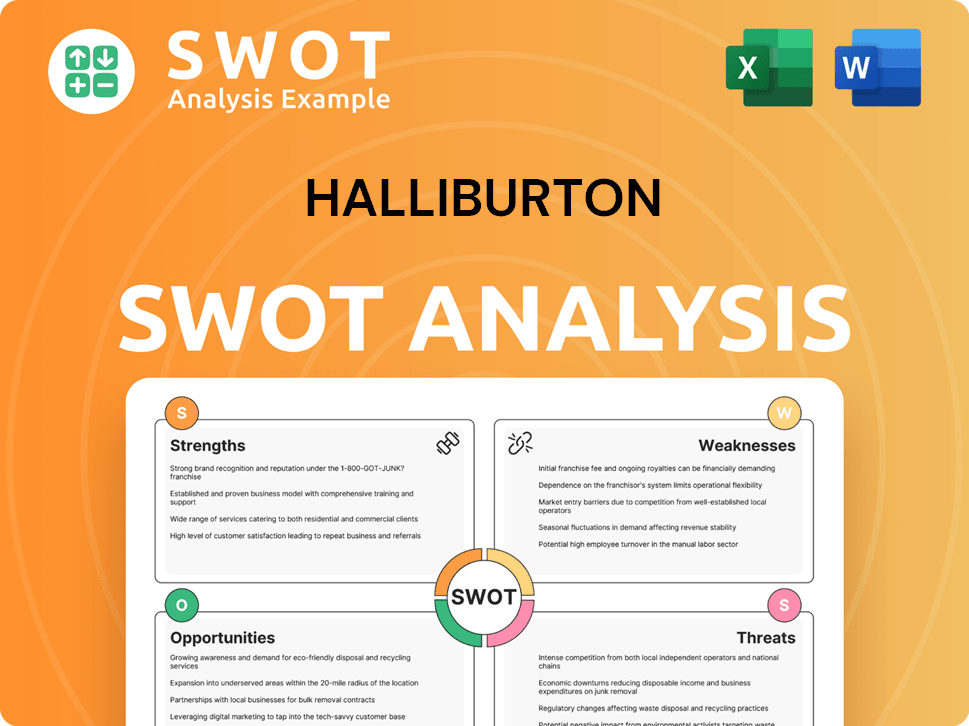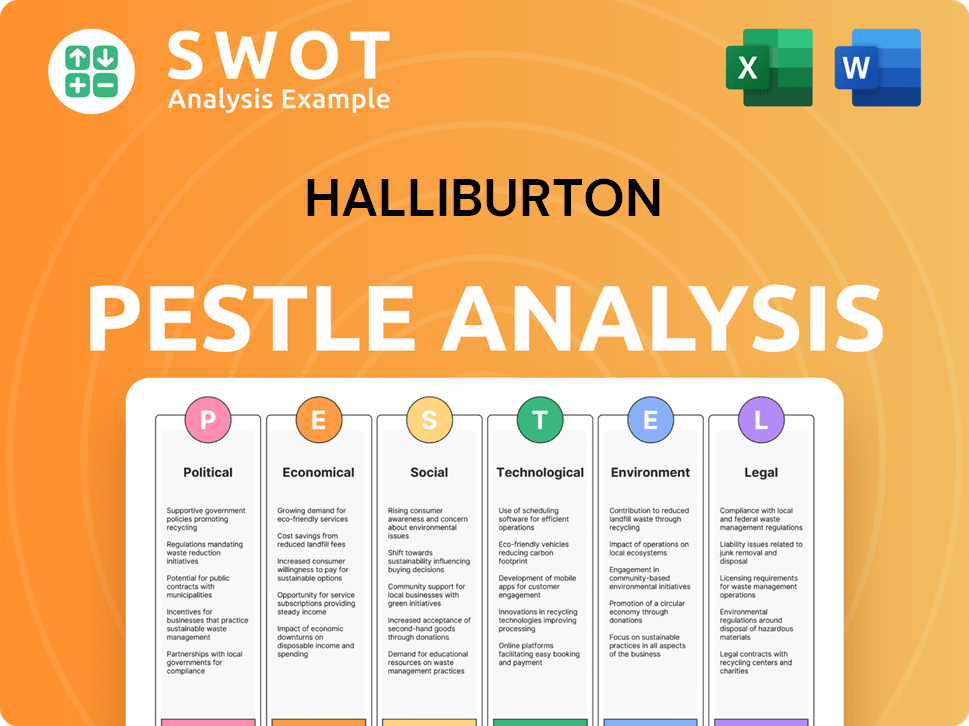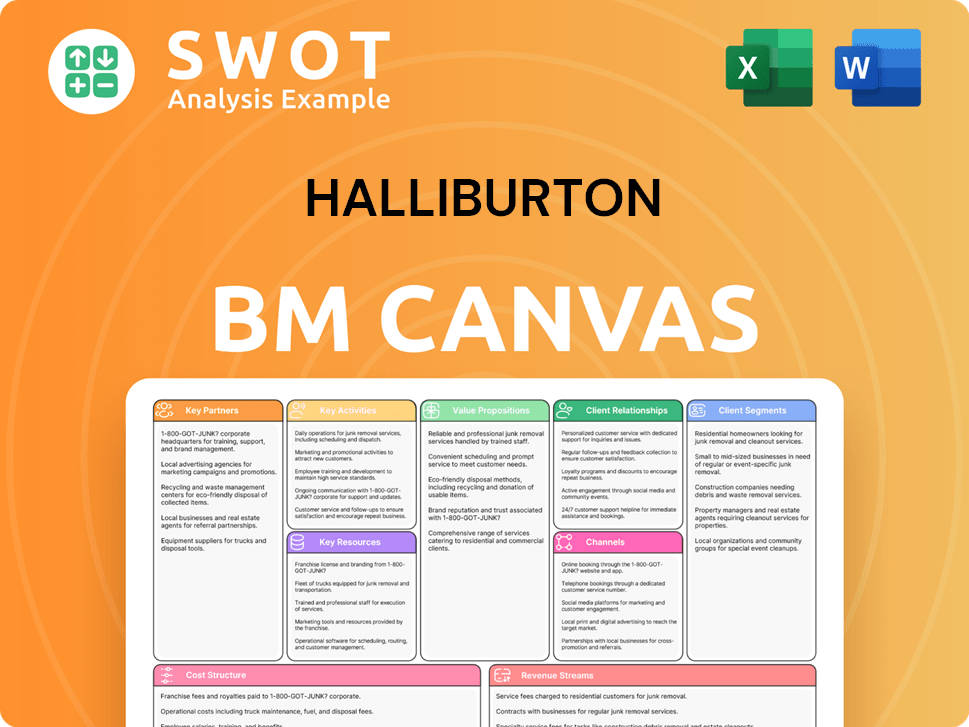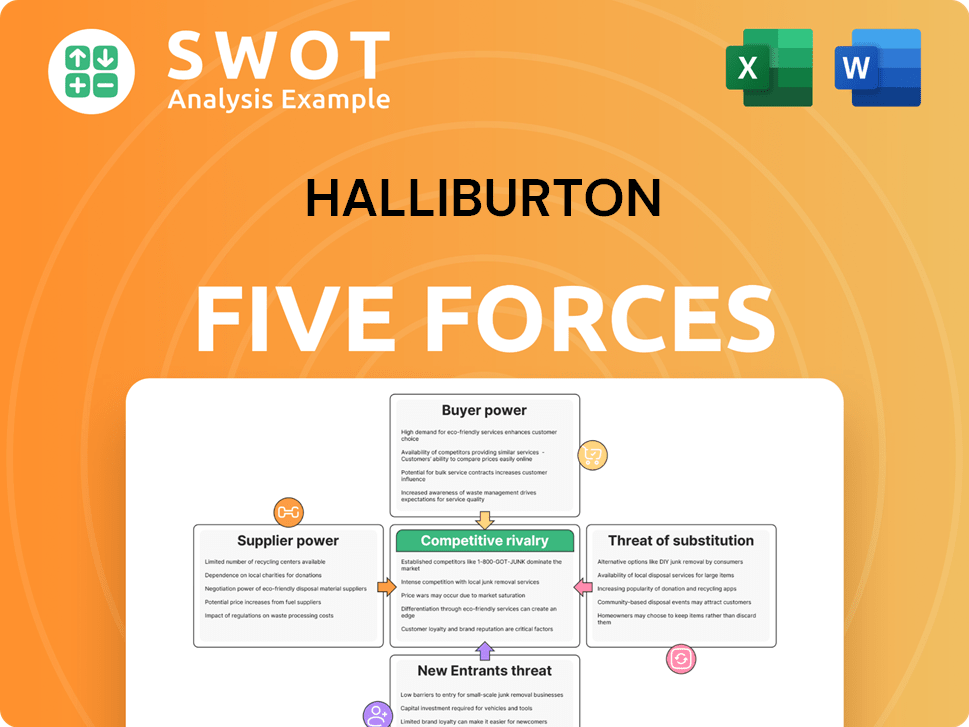Halliburton Bundle
Can Halliburton Maintain Its Dominance in the Energy Services Arena?
Halliburton, a titan in the oilfield services industry since 1919, has continuously adapted to the ever-changing demands of the energy sector. From its humble beginnings in well cementing, the company has evolved into a global powerhouse, offering a vast array of services to upstream oil and gas clients. As of June 2025, Halliburton boasts a market capitalization of approximately €15.07 billion, a testament to its enduring influence.

This exploration delves into the Halliburton SWOT Analysis, examining its position within the Halliburton competitive landscape and the strategies it employs to maintain its competitive edge. We will dissect Halliburton's market share, analyze its primary rivals, and assess its competitive advantages in the face of industry challenges. A thorough Halliburton market analysis will reveal how it navigates the complexities of the energy sector competition and its future outlook.
Where Does Halliburton’ Stand in the Current Market?
Halliburton holds a significant position within the oilfield services industry, competing with major players such as Schlumberger and Baker Hughes. The company's operations are primarily divided into two key segments: Completion and Production, and Drilling and Evaluation. These divisions provide a comprehensive suite of services, including cementing, stimulation, well construction, and reservoir modeling, catering to the diverse needs of the oil and gas sector.
As of Q1 2025, Halliburton's market share in the oil and gas production industry was 26.23%, demonstrating its substantial influence. Halliburton's global presence is well-established, serving clients in over 70 countries and employing a diverse workforce. This global reach allows Halliburton to capitalize on opportunities in various regions and adapt to regional market dynamics.
Financially, Halliburton reported a total revenue of $5.417 billion in Q1 2025, reflecting a 7% decrease compared to Q1 2024. Despite this, the company maintains a healthy free cash flow, providing flexibility for operations and strategic investments. Halliburton's return on equity of 25.18% in April 2025 highlights its strong ability to generate profits.
Halliburton's significant market share in the oilfield services industry positions it as a key player. The company competes directly with major rivals, including Schlumberger and Baker Hughes. Its strong market share indicates a robust competitive standing and the ability to secure substantial contracts within the energy sector.
Halliburton's revenue is primarily generated from its Completion and Production, and Drilling and Evaluation segments. In Q1 2025, total revenue was $5.417 billion, reflecting a 7% decrease. The Completion and Production segment focuses on services like cementing and stimulation. The Drilling and Evaluation segment provides well construction and reservoir modeling solutions.
Halliburton operates in over 70 countries, with a global workforce exceeding 48,000 employees from 145 nationalities as of Q4 2024. International markets account for a significant portion of its revenue. The Middle East/Asia region led international growth with a 7% increase in revenue, reaching $1.6 billion in Q4 2024.
Despite a decrease in Q1 2025 revenue, Halliburton maintains a healthy free cash flow of approximately $1.6 billion as of April 2025. The company's return on equity of 25.18% in April 2025 demonstrates its efficiency in generating profits. Halliburton is strategically focusing on international growth opportunities.
Halliburton's competitive advantages are rooted in its extensive global presence and comprehensive service offerings. The company's ability to provide a wide range of services, from well construction to production optimization, allows it to serve a diverse client base effectively. This integrated approach enhances its market position.
- Global Footprint: Operations in over 70 countries.
- Service Diversity: Comprehensive offerings across the oilfield lifecycle.
- Financial Strength: Strong free cash flow and return on equity.
- Strategic Focus: Pursuing growth opportunities internationally.
Halliburton SWOT Analysis
- Complete SWOT Breakdown
- Fully Customizable
- Editable in Excel & Word
- Professional Formatting
- Investor-Ready Format

Who Are the Main Competitors Challenging Halliburton?
The Halliburton competitive landscape is shaped by intense rivalry within the oilfield services industry. The company faces competition from both established giants and emerging players, all vying for market share in a dynamic global market. This competition impacts pricing, innovation, and technological advancements.
Halliburton's market analysis reveals a complex environment where strategic moves, such as mergers and acquisitions, significantly influence competitive dynamics. Understanding the strengths and weaknesses of its rivals is crucial for Halliburton to maintain and grow its position in the energy sector.
Halliburton's market share is influenced by its ability to compete effectively with major players like Schlumberger and Baker Hughes. The company's strategies must address challenges related to technological innovation, global presence, and operational efficiency to succeed in this demanding industry.
The primary competitors of Halliburton include Schlumberger (SLB), Baker Hughes (BKR), and Weatherford International (WFRD). These companies offer similar services and compete globally for market share.
Additional competitors include TechnipFMC (FTI), NOV (NOV), Tidewater (TDW), Oceaneering International (OII), RPC (RES), Helix Energy Solutions Group (HLX), TETRA Technologies (TTI), Natural Gas Services Group (NGS), and Oil States International (OIS).
Competitors challenge Halliburton through various means, including price, innovation, branding, distribution, and technology. For example, Schlumberger is known for its global presence and technological expertise, offering a wide range of services.
The industry has seen new and emerging players disrupting the traditional landscape, particularly in hydraulic fracturing. Advances in technology and lower barriers to entry have led to an influx of new competitors.
Mergers and alliances impact competitive dynamics. While Halliburton's attempted acquisition of Baker Hughes in 2016 did not materialize, such potential consolidations highlight the industry's drive for scale and expanded offerings.
Technological advancements are a key factor in the competitive landscape. Companies that invest in innovation and new technologies gain a competitive edge. The ability to offer more efficient and cost-effective solutions is crucial.
The Halliburton competitive landscape is significantly influenced by the strategies of its main rivals. For instance, Schlumberger, a major competitor, reported revenues of approximately $42.8 billion in 2023, demonstrating its strong market position. Baker Hughes, another key player, generated revenues of around $25.5 billion in 2023. These figures highlight the scale of competition and the financial pressures within the industry. The intense competition necessitates that Halliburton continually innovate and adapt to maintain its market share. Furthermore, the industry's volatility, influenced by factors like fluctuating oil prices and geopolitical events, adds another layer of complexity to the competitive environment. To understand how Halliburton approaches marketing in this environment, you can read more in the Marketing Strategy of Halliburton article.
- Schlumberger: Reported revenues of approximately $42.8 billion in 2023.
- Baker Hughes: Generated revenues of around $25.5 billion in 2023.
- Industry Trends: The oilfield services industry is influenced by technological advancements, mergers, and acquisitions.
- Market Dynamics: Competition is driven by factors like pricing, innovation, and global presence.
Halliburton PESTLE Analysis
- Covers All 6 PESTLE Categories
- No Research Needed – Save Hours of Work
- Built by Experts, Trusted by Consultants
- Instant Download, Ready to Use
- 100% Editable, Fully Customizable

What Gives Halliburton a Competitive Edge Over Its Rivals?
Halliburton's competitive advantages are rooted in its proprietary technologies, expansive global network, strong customer relationships, and consistent investment in research and development. These elements collectively position the company as a leader in the oilfield services industry. The company's strategic focus on innovation and operational excellence has allowed it to maintain a strong competitive edge in a dynamic market.
The company's technological leadership is a key differentiator in the competitive landscape. Halliburton invests significantly in research and development, with expenditures around $800 million in 2022. This investment fuels cutting-edge solutions that optimize well construction and reservoir management. This commitment to innovation enables Halliburton to offer advanced services and maintain a competitive advantage.
Halliburton's well-established global network provides it with a significant advantage, enabling it to serve clients in diverse geographic locations. This global reach and extensive technology portfolio make Halliburton a leader in the global services marketplace. The company's strategic initiatives also include digital transformation, sustainability solutions, and integrated services that cover the entire lifecycle of a well.
Halliburton's technological advancements, like advanced hydraulic fracturing, have significantly improved well productivity. In Q4 2024, Halliburton highlighted innovations such as Intelli Diagnostic Well Intervention Services and iCruise® Force. These technologies enhance efficiency and reduce environmental impact, bolstering their competitive position.
Halliburton's global presence allows it to serve clients worldwide, fostering long-term relationships with major oil and gas companies. This global reach and its comprehensive technology portfolio help Halliburton maintain a leading position in the market. The company's strategic initiatives also include digital transformation, sustainability solutions, and integrated services that cover the entire lifecycle of a well.
Halliburton is actively pursuing digital transformation through cloud-based services and AI solutions. The company is also committed to sustainability solutions, integrating them into its service offerings. These initiatives enhance operational efficiency and align with the industry's evolving needs.
Halliburton's consistent investment in R&D, with expenditures around $800 million in 2022, supports its competitive edge. The company's focus on developing technologies that maximize customer asset value is a key driver. Halliburton Labs, an initiative fostering innovation through collaboration with startups, further underscores its commitment to advancing the energy sector.
Halliburton's competitive advantages include its technological leadership, extensive global network, and strong customer relationships. These advantages are supported by continuous investment in research and development and strategic initiatives focused on digital transformation and sustainability. The company's ability to innovate and adapt to industry changes is crucial.
- Technological Leadership: Advanced hydraulic fracturing and digital solutions.
- Global Presence: Serving clients worldwide with a strong network.
- Customer Relationships: Long-term partnerships with major oil and gas companies.
- R&D Investment: Approximately $800 million in 2022, driving innovation.
The company's ability to innovate and adapt to industry changes is crucial for its long-term success. For more insights into Halliburton's strategic direction, consider reading about the Growth Strategy of Halliburton.
Halliburton Business Model Canvas
- Complete 9-Block Business Model Canvas
- Effortlessly Communicate Your Business Strategy
- Investor-Ready BMC Format
- 100% Editable and Customizable
- Clear and Structured Layout

What Industry Trends Are Reshaping Halliburton’s Competitive Landscape?
The oil and gas industry is currently undergoing significant transformation, driven by technological advancements, evolving regulatory landscapes, and global economic shifts. These factors are reshaping the competitive landscape for companies like Halliburton. The increasing demand for advanced digital oilfield management solutions, with the market projected to reach $26.5 billion by 2025, presents a significant opportunity for growth and innovation.
Halliburton faces both challenges and opportunities in this dynamic environment. While the company must navigate intensifying competition and evolving regulations, it is also strategically positioned to capitalize on technological innovation, expand into new markets, and leverage its strengths in a rapidly changing industry. Understanding the Halliburton competitive landscape is crucial for investors and stakeholders looking to make informed decisions in the energy sector.
Technological advancements, including AI and machine learning, are becoming integral to drill data management, offering advanced analytics and predictive maintenance capabilities. Sustainability is gaining importance, with consumers and regulators pushing for eco-friendly materials and energy-efficient processes. The digital oilfield market is expected to continue its growth, driven by the need for enhanced efficiency and data-driven decision-making.
Intensifying competition from new entrants and agile startups poses a threat to established players. Regulatory compliance challenges, with constantly evolving regulations, require continuous adaptation. The shift towards net-zero emissions presents both challenges and opportunities, demanding significant investments in sustainable technologies and practices.
Technological innovation provides avenues to enhance efficiency and reduce costs for clients. Expansion into new markets, particularly in regions with growing energy demands, offers significant growth potential. Strategic acquisitions can strengthen market position and expand service offerings. Emerging markets in Africa and Southeast Asia present substantial opportunities, with a combined market potential estimated at $124 billion by 2027.
Halliburton is focusing on digital transformation, sustainability solutions, and integrated services. Investments in technologies like EarthStar 3DX for real-time geological insights and the Octiv Auto Frac system for automated hydraulic fracturing are key. The company is actively involved in low-carbon energy projects like Carbon Capture, Utilization, and Storage (CCUS) and geothermal energy. The company expects to return at least $1.6 billion of cash in 2025.
Halliburton's competitive position is expected to evolve through its continued focus on international growth, deepening its technology portfolio, and delivering incremental revenue through its growth engines. The company emphasizes digital transformation, sustainability solutions, and integrated services to enhance efficiency and reduce environmental impact. Strategic initiatives are geared towards digital transformation, sustainability solutions, and integrated services. A deeper dive into the company's business model can be found in this article: Revenue Streams & Business Model of Halliburton.
- Focus on international growth.
- Deepening its technology portfolio.
- Delivering incremental revenue through its growth engines: drilling technology, unconventionals, well intervention, and artificial lift.
- Emphasis on digital transformation and sustainability.
Halliburton Porter's Five Forces Analysis
- Covers All 5 Competitive Forces in Detail
- Structured for Consultants, Students, and Founders
- 100% Editable in Microsoft Word & Excel
- Instant Digital Download – Use Immediately
- Compatible with Mac & PC – Fully Unlocked

Related Blogs
- What are Mission Vision & Core Values of Halliburton Company?
- What is Growth Strategy and Future Prospects of Halliburton Company?
- How Does Halliburton Company Work?
- What is Sales and Marketing Strategy of Halliburton Company?
- What is Brief History of Halliburton Company?
- Who Owns Halliburton Company?
- What is Customer Demographics and Target Market of Halliburton Company?
Disclaimer
All information, articles, and product details provided on this website are for general informational and educational purposes only. We do not claim any ownership over, nor do we intend to infringe upon, any trademarks, copyrights, logos, brand names, or other intellectual property mentioned or depicted on this site. Such intellectual property remains the property of its respective owners, and any references here are made solely for identification or informational purposes, without implying any affiliation, endorsement, or partnership.
We make no representations or warranties, express or implied, regarding the accuracy, completeness, or suitability of any content or products presented. Nothing on this website should be construed as legal, tax, investment, financial, medical, or other professional advice. In addition, no part of this site—including articles or product references—constitutes a solicitation, recommendation, endorsement, advertisement, or offer to buy or sell any securities, franchises, or other financial instruments, particularly in jurisdictions where such activity would be unlawful.
All content is of a general nature and may not address the specific circumstances of any individual or entity. It is not a substitute for professional advice or services. Any actions you take based on the information provided here are strictly at your own risk. You accept full responsibility for any decisions or outcomes arising from your use of this website and agree to release us from any liability in connection with your use of, or reliance upon, the content or products found herein.